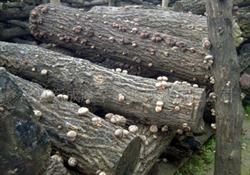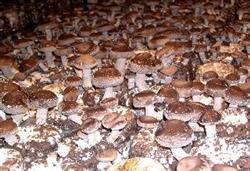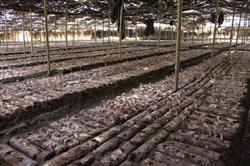Production technology of pollution-free Lentinus edodes

The pollution-free production technology of Lentinus edodes mainly includes optimizing the ecological environment of producing area, checking the cultivation raw materials, selecting excellent bacteria, standardizing the production of bacterial bags, scientific management of mushroom production, controlling the use of pesticides, product standardization and so on. And every link should be operated strictly in accordance with scientific and technological procedures to make the products meet the requirements of the national agricultural industry standard NY-2002. 1. requirements of pollution-free Lentinus edodes seed culture room 1. Lentinus edodes strain culture room must be away from the food brewing industry, livestock houses, hospitals and residential areas, at least 1000 meters away. 2. The Lentinus edodes strain culture room should be located north to south, the environment is clean, and the air quality reaches grade I, free of sulfur dioxide, nitrogen oxides, fluoride, lead and so on. The windows are required to be equipped with insect-proof nets, and the walls are painted white and free of dust. 3. The disinfectants used in the strain culture room should choose pollution-free agents, such as calcium hypochlorite, to contact the air to quickly produce substances that are harmless to the environment, the human body and the production of Lentinus edodes, so as to eliminate pathogenic microorganisms. 4. install ultraviolet lamp lighting in the strain culture room or replace chemical sterilization with physical disinfection methods such as electronic ozone sterilizer. Technical requirements for the production of Lentinus edodes 1. The site of the field mushroom shed must be close to the flowing water source, the surrounding area is wide, the air is fresh and smooth, and there is no waste such as garbage, so as to put an end to pollution sources. 2. The ground of the mushroom shed must be deeply whitened and leveled, and the soil covered with soil should conform to the regulations of GB 1568, that is, the indexes of mercury, arsenic, lead, cadmium, BHC and DDT should not exceed the standard. 3. The mushroom bed in the field mushroom shed must be sprinkled with stone powder or sprayed with biological agents such as rapeseed cake, tobacco and so on. 4. The water source of the mushroom shed must be pollution-free, the water quality must be clean, and the water quality should conform to the provisions of the national GB5749. 5. crop rotation must be reasonable, planting mushrooms in one year, rice and wheat vegetables in one year, and spreading hosts in the middle through rotation, so as to reduce the accumulation of diseases and insect pests and avoid continuous cropping to aggravate diseases and pests. Third, the requirements of raw materials and auxiliary materials of Lentinus edodes 1, the quality of material collection, raw materials require fresh, no mildew deterioration phenomenon, cottonseed shell, wheat bran and other crop scraps as raw materials, agricultural residue testing must be carried out, only the raw materials that do not exceed the standard can be used to cultivate pollution-free shiitake mushrooms. 2, sterilization, raw materials should be exposed to the sun before entering the warehouse to kill pathogens, pests and maggots. 3. Store the damp-proof pass, and the warehouse where the raw materials are stored is required to be dry, ventilated, rain-proof and moisture-proof, so as to ensure that the raw materials do not mildew and deteriorate. 4. Stack fermentation should be done in advance when raw materials are used in order to kill miscellaneous bacteria and insect pests lurking in raw materials. Stacking materials can also choose pollution-free agents for sterilization and insecticide, but high toxic and high residual pesticides such as methamidophos are prohibited so as not to cause agricultural residues.
- Prev

Cultivation of Lentinus edodes without off-bag layer shelf culture with temperature difference to promote bud
The growing stage of Pleurotus ostreatus is in the season of high temperature, which is disadvantageous to the growth and development of fruiting body. Poor management is prone to wilting and rotten mushrooms. How to make use of cultivation and protection facilities and take corresponding measures to restrict the impact of adverse environment? This is the most important link in the management of mushroom cultivation in summer. According to the experience of the main producing areas, the main measures such as.
- Next

How to improve the efficiency of mushroom cultivation
At this stage, due to the proliferation of a large number of hyphae, not only a large number of hyphae, but also stored rich nutrients, at this time hyphae have entered the physiological maturity, such as continue to give constant temperature, sufficient water and fresh air, hyphae will maintain an active growth state, difficult to enter the fruiting body this stage. Therefore, in bacteria...
Related
- Fuxing push coffee new agricultural production and marketing class: lack of small-scale processing plants
- Jujube rice field leisure farm deep ploughing Yilan for five years to create a space for organic food and play
- Nongyu Farm-A trial of organic papaya for brave women with advanced technology
- Four points for attention in the prevention and control of diseases and insect pests of edible fungi
- How to add nutrient solution to Edible Fungi
- Is there any good way to control edible fungus mites?
- Open Inoculation Technology of Edible Fungi
- Is there any clever way to use fertilizer for edible fungus in winter?
- What agents are used to kill the pathogens of edible fungi in the mushroom shed?
- Rapid drying of Edible Fungi

